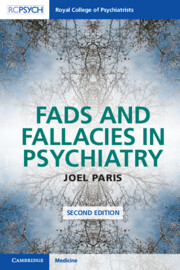Book contents
- Fads and Fallacies in Psychiatry
- Fads and Fallacies in Psychiatry
- Copyright page
- Dedication
- Contents
- Preface to the Second Edition
- Acknowledgments
- Introduction
- Chapter 1 Fads and Fallacies in Science, Medicine, and Psychology
- Chapter 2 Psychiatric Fads: Past and Present
- Chapter 3 Etiological Fads
- Chapter 4 Diagnostic Fads
- Chapter 5 Psychopharmacology Fads
- Chapter 6 Psychotherapy Fads
- Chapter 7 Prevention Fads
- Chapter 8 Antidotes to Fads and Fallacies
- Chapter 9 Overview
- References
- Index
- References
References
Published online by Cambridge University Press: 16 March 2023
- Fads and Fallacies in Psychiatry
- Fads and Fallacies in Psychiatry
- Copyright page
- Dedication
- Contents
- Preface to the Second Edition
- Acknowledgments
- Introduction
- Chapter 1 Fads and Fallacies in Science, Medicine, and Psychology
- Chapter 2 Psychiatric Fads: Past and Present
- Chapter 3 Etiological Fads
- Chapter 4 Diagnostic Fads
- Chapter 5 Psychopharmacology Fads
- Chapter 6 Psychotherapy Fads
- Chapter 7 Prevention Fads
- Chapter 8 Antidotes to Fads and Fallacies
- Chapter 9 Overview
- References
- Index
- References
Summary

- Type
- Chapter
- Information
- Fads and Fallacies in Psychiatry , pp. 115 - 132Publisher: Cambridge University PressPrint publication year: 2023

